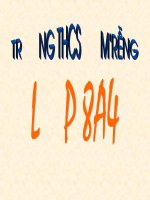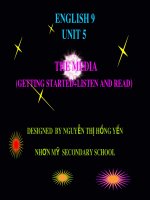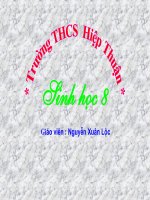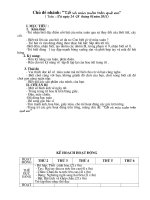bài giảng tăng uric máu và gout hyperuricemia and gout
Bạn đang xem bản rút gọn của tài liệu. Xem và tải ngay bản đầy đủ của tài liệu tại đây (5 MB, 110 trang )
<span class="text_page_counter">Trang 1</span><div class="page_container" data-page="1">
<b>TĂNG URIC MÁU VÀ GOUT</b>
<b>Hyperuricemia and Gout</b>
ThS.BS. Võ Thanh Phong
<b><small>1</small></b>
</div><span class="text_page_counter">Trang 3</span><div class="page_container" data-page="3"><b>Chương 1</b>
<b>Định nghĩa và tổng quan</b>
<b><small>3</small></b>
</div><span class="text_page_counter">Trang 4</span><div class="page_container" data-page="4"><b>Thuật ngữ gout được sử dụng đại diện cho một nhóm các bệnh khơng</b>
<b>đồng nhất ở người bao gồm các đặc điểm:</b>
• Tăng nồng độ urate huyết thanh (hyperuricemia)
• Viêm khớp tái phát chứng minh được hiện diện tinh thể monosodium urate monohydrate trong bạch cầu chất hoạt dịch
• Lắng đọng tinh thể sodium urate monohydrate (tophi) trong và quanhkhớp đôi lúc gây phá hủy và biến dạng khớp
• Bệnh thận bao gồm cầu thận, ống thận, mơ kẽ thận và mạch máu thận• Sỏi acid uric ở thận.
<b>Định nghĩa và TỔNG QUAN</b>
<small>Source: Burns, Christopher M. and Wortmann, Robert L. (2017), "Clinical Features and Treatment </small>
<i><small>of Gout", in Firestein, Gary S., et al., Editors, Kelley and Firestein’s Textbook of Rheumatology, </small></i>
<small>Elsevier, pp. 1620-1642..</small>
<b><small>4</small></b>
</div><span class="text_page_counter">Trang 5</span><div class="page_container" data-page="5"><b><small>Benjamin Franklin </small><sup>Isaac Newton</sup><sup>Charles Robert Darwin</sup></b>
<b><small>“disease of kings and king of diseases”</small></b>
</div><span class="text_page_counter">Trang 6</span><div class="page_container" data-page="6"><b><small>6</small></b>
</div><span class="text_page_counter">Trang 7</span><div class="page_container" data-page="7"><b>Tần suất gout</b>
• Hoa kỳ 2007-2008: 3.9% → 8.3 triệu người
• Rochester Epidemiology Project: gout tăng gấp đơi từ 20.2/100,000 in1977/1978 đến 45.9/100,000 in 1995/1996
• Gout tăng theo nồng độ urate: 4.9% (>9 mg/dL), 0.5% (7-8.9 mg/dL), 0.1% (<7 mg/dL)
<b>Tần suất tăng uric máu</b>
• Tăng uric máu: 2.6% đến 47.2% tùy dân số
<b>Nống độ uric huyết thanh tăng theo tuổi, giới</b>
<small>Source: Burns, Christopher M. and Wortmann, Robert L. (2017), "Clinical Features and Treatment </small>
<i><small>of Gout", in Firestein, Gary S., et al., Editors, Kelley and Firestein’s Textbook of Rheumatology, </small></i>
<small>Elsevier, pp. 1620-1642..</small>
</div><span class="text_page_counter">Trang 8</span><div class="page_container" data-page="8"><b>Dịch tễ học</b>
<small>Source: Kuo, C.-F. et al. (2015), Global epidemiology of gout: prevalence, incidence and risk </small>
<i><small>factors. Nat. Rev. Rheumatol. doi:10.1038/nrrheum.2015.91</small></i>
</div><span class="text_page_counter">Trang 9</span><div class="page_container" data-page="9"><b>Dịch tễ học</b>
<i><small>Source: Kuo, C.-F. et al. (2015), Global epidemiology of gout: prevalence, incidence and risk factors. Nat. Rev. </small></i>
<i><small>Rheumatol. doi:10.1038/nrrheum.2015.91. 2. Smith E, et al. Ann Rheum Dis. 2014;73(8):1470-1476;</small></i>
<small>3. class="text_page_counter">Trang 10</span><div class="page_container" data-page="10">
• Đồ uống có cồn
• Thực phẩm nhiểu fructose• Trà, cà phê, caffeine
• Vitamin C
• Thuốc và tiếp xúc chì
<b>Các yếu tố nguy cơ của tăng uric máu và gout</b>
<small>Source: Vogelmeier, Claus F., et al. (2017), Global strategy for the diagnosis, management, and </small>
</div><span class="text_page_counter">Trang 11</span><div class="page_container" data-page="11"><b>Chương 2</b>
<b>Cơ chế bệnh sinh</b>
<b><small>11</small></b>
</div><span class="text_page_counter">Trang 12</span><div class="page_container" data-page="12">Gout cấp tự giới hạn, đặc biệt trong giai đoạn sớm của bệnh.
Tinh thể urate bị bao bọc bởi protein hoạt dịch (như apolipoproteins B vàE), do đó ức chế khả năng gây viêm của chúng.
Stress của đợt cấp gout có thể thúc đẩy bài tiết ACTH, ACTH có thể liênkết trực tiếp với melanocyte-stimulating hormone receptors để gây hiệuquả kháng viêm.
Tinh thể urate kích thích trực tiếp biểu hiện của PPARγ → điều hòahướng lên biểu hiện của PGD2 và 15d-PGJ2 làm giảm quá trình viêm.
15d-PGJ2 ức chế tiết IL-1β, IL-6, IL-12, TNF từ macrophage.
<b>ACUTE GOUT FLARES:</b>
<b>Giải quyết đợt cấp</b>
<small>Source: Keenan, Robert T., Krasnokutsky, Svetlana, and Pillinger, Michael H. (2017), "Etiology and </small>
<i><small>Pathogenesis of Hyperuricemia and Gout", in Firestein, Gary S., et al., Editors, Kelley and </small></i>
<i><small>Firestein’s Textbook of Rheumatology, Elsevier, pp. 1597-1617..</small></i>
</div><span class="text_page_counter">Trang 13</span><div class="page_container" data-page="13">Gout không điều trị dẫn đến tiến triển cuối cùng thành giai đoạn đặc trưng
<b>bởi viêm mạn tính và hoặc hình thành các mảng tích tụ urate đại thểđược gọi là tophi.</b>
Trong giai đoạn không triệu chứng, khoảng thời gian giữa các đợt cấp,
<b>viêm mạn tính mức độ thấp vẫn tồn tại, với sự thực bào liên tiếp của </b>
bạch cầu với các tinh thể.
Viêm mạn hoạt dịch, mất sụn, bào mòn xương, là dấu hiệu tiến triển củaviêm gout mạn
<b>Chronic Gouty Arthritis and Tophaceous Gout:</b>
<small>Source: Keenan, Robert T., Krasnokutsky, Svetlana, and Pillinger, Michael H. (2017), "Etiology and </small>
<i><small>Pathogenesis of Hyperuricemia and Gout", in Firestein, Gary S., et al., Editors, Kelley and </small></i>
<i><small>Firestein’s Textbook of Rheumatology, Elsevier, pp. 1597-1617..</small></i>
</div><span class="text_page_counter">Trang 14</span><div class="page_container" data-page="14">Cấu trúc tophi 3 lớp:
• Tinh thể MSU và các mảnh vỡ thành vùng trung tâm.
• Vùng viền: macrophage, macrophage đa nhân, tương bào, tế bàomast.
• Lớp ngồi cùng là mô liên kết/vùng xơ mạch (fibrovascular)
Mặc dù đặc trưng cho gout trễ, tophi có thể xảy ra sớm, đặc biệt trênbệnh nhân suy thận và nồng độ urate cao.
Một số BN, tophi có thể xuất hiện thậm chí khi khơng có đợt cấp nào
<b>Chronic Gouty Arthritis and Tophaceous Gout:</b>
<small>Source: Keenan, Robert T., Krasnokutsky, Svetlana, and Pillinger, Michael H. (2017), "Etiology and </small>
<i><small>Pathogenesis of Hyperuricemia and Gout", in Firestein, Gary S., et al., Editors, Kelley and </small></i>
<i><small>Firestein’s Textbook of Rheumatology, Elsevier, pp. 1597-1617..</small></i>
</div><span class="text_page_counter">Trang 15</span><div class="page_container" data-page="15"><b>Chronic Gouty Arthritis and Tophaceous Gout:</b>
<small>Source: Keenan, Robert T., Krasnokutsky, Svetlana, and Pillinger, Michael H. (2017), "Etiology and </small>
<i><small>Pathogenesis of Hyperuricemia and Gout", in Firestein, Gary S., et al., Editors, Kelley and </small></i>
<i><small>Firestein’s Textbook of Rheumatology, Elsevier, pp. 1597-1617..</small></i>
</div><span class="text_page_counter">Trang 16</span><div class="page_container" data-page="16">Tophi có vai trị quan <b>trọng trong việc dự trữ tinh thể urate và khả năng</b>
gây tổn thương mô: xương, sụn, và dây chằng và các cấu trúc mô mềmkhác.
Các yếu tố cơ học, enzyme ly giải, sự tổng hợp các cytokine tiền viêmgóp phần thúc đầy bào mòn và phá hủy khớp của tophi.
Đại thực bào của tophi sản xuất IL-1β, TNF, IL-6, IL-17, MMP-2, MMP-9, và macrophage CSF (M-CSF). IL-1β và các cytokine khác gây ức chế tácđộng duy trì xương của tạo cốt bào.
Tế bào T của tophi thúc đẩy bào mịn xương thơng qua hoạt hóa thụ thểcủa NF-κB (RANK) ligand, yếu tố thúc đẩy chính hình thành hủy cốt bàovà hoạt hóa hủy cốt bào
<b>Chronic Gouty Arthritis and Tophaceous Gout:</b>
<small>Source: Keenan, Robert T., Krasnokutsky, Svetlana, and Pillinger, Michael H. (2017), "Etiology and </small>
<i><small>Pathogenesis of Hyperuricemia and Gout", in Firestein, Gary S., et al., Editors, Kelley and </small></i>
<i><small>Firestein’s Textbook of Rheumatology, Elsevier, pp. 1597-1617..</small></i>
</div><span class="text_page_counter">Trang 17</span><div class="page_container" data-page="17"><b>Tăng huyết áp</b>
• Urate hòa tan ức chế tổng hợp các nitric oxide dãn mạch; gây tăngsinh cơ trơn bằng cách hoạt hóa MAP kinase; và kích thích tổng hợpCOX-2 và PDGF → gây co động mạch.
• Urate hịa tan tác động trực tiếp kích thích hệ thống renin-angiotensin ở thận và gây viêm ống thận mơ kẽ.
<b>Nguy cơ tim mạch</b>
• Tăng uric máu có thể góp phần vào nguy cơ tim mạch
• Giảm urate huyết thanh có thể làm giảm nguy cơ nhồi máu cơ tim vàlàm chậm diễn tiến của suy thận
<b>Tăng uric máu ở người khơng có gout</b>
<small>Source: Keenan, Robert T., Krasnokutsky, Svetlana, and Pillinger, Michael H. (2017), "Etiology and </small>
<i><small>Pathogenesis of Hyperuricemia and Gout", in Firestein, Gary S., et al., Editors, Kelley and </small></i>
<i><small>Firestein’s Textbook of Rheumatology, Elsevier, pp. 1597-1617..</small></i>
</div><span class="text_page_counter">Trang 18</span><div class="page_container" data-page="18"><small>Source: Keenan, Robert T., Krasnokutsky, Svetlana, and Pillinger, Michael H. (2017), "Etiology and </small>
<i><small>Pathogenesis of Hyperuricemia and Gout", in Firestein, Gary S., et al., Editors, Kelley and </small></i>
<i><small>Firestein’s Textbook of Rheumatology, Elsevier, pp. 1597-1617..</small></i>
</div><span class="text_page_counter">Trang 19</span><div class="page_container" data-page="19"><b>Chương 3</b>
<b>Lâm sàng</b>
<b><small>19</small></b>
</div><span class="text_page_counter">Trang 20</span><div class="page_container" data-page="20"><b>Đợt tấn cơng đầu tiên</b>
• Nam: 40-60 tuổi• Nữ: >60 tuổi
• <25 tuổi → tìm ngun nhân di truyền, thuốc• 85%-90% ở 1 khớp
<b>Vị trí</b>
• Khớp bàn ngón chân cái hay gặp nhất (50%/đợt đầu, 90%/tổng)• Thường ở chi dưới, tuy nhiên có thể ở khớp bất kì
• Mắt cá > gót >gối >cổ tay >ngón tay >khuỷu
<b>Acute Gouty Arthritis</b>
<small>Source: Keenan, Robert T., Krasnokutsky, Svetlana, and Pillinger, Michael H. (2017), "Etiology and </small>
<i><small>Pathogenesis of Hyperuricemia and Gout", in Firestein, Gary S., et al., Editors, Kelley and </small></i>
<i><small>Firestein’s Textbook of Rheumatology, Elsevier, pp. 1597-1617..</small></i>
</div><span class="text_page_counter">Trang 21</span><div class="page_container" data-page="21"><b>Hồn cảnh khởi phát</b>
• Đột ngột, thường ban đêm lúc đi ngủ
• Thuốc làm tăng/giảm urate huyết thanh cấp tính
• Chấn thương, rượu, phẫu thuật, chế độ ăn, xuất huyết, điều trị với protein lạ, nhiễm trùng, chất cản quang
<b>Tiền triệu</b>
• Rối loạn TK: đau đầu, kích thích, mệt mỏi• Rối loạn TH: đau thượng vị, táo bón, ợ hơi• Rối loạn tiết niệu: tiểu nhiều, tiểu gắt
• Tại chỗ: khó cử động, tê ngón chân cái
<b>Acute Gouty Arthritis</b>
<small>Source: Keenan, Robert T., Krasnokutsky, Svetlana, and Pillinger, Michael H. (2017), "Etiology and </small>
<i><small>Pathogenesis of Hyperuricemia and Gout", in Firestein, Gary S., et al., Editors, Kelley and </small></i>
<i><small>Firestein’s Textbook of Rheumatology, Elsevier, pp. 1597-1617..</small></i>
</div><span class="text_page_counter">Trang 22</span><div class="page_container" data-page="22">• Triệu chứng tự giải quyết trong 3-14 ngày
<b>Triệu chứng tồn thân</b>
• Mệt mỏi, ăn kém• Sốt 38-38.5<small>o</small>C
<b>Acute Gouty Arthritis</b>
<small>Source: Keenan, Robert T., Krasnokutsky, Svetlana, and Pillinger, Michael H. (2017), "Etiology and </small>
<i><small>Pathogenesis of Hyperuricemia and Gout", in Firestein, Gary S., et al., Editors, Kelley and </small></i>
<i><small>Firestein’s Textbook of Rheumatology, Elsevier, pp. 1597-1617..</small></i>
</div><span class="text_page_counter">Trang 23</span><div class="page_container" data-page="23"><b>Acute Gouty Arthritis</b>
<small>Source: Keenan, Robert T., Krasnokutsky, Svetlana, and Pillinger, Michael H. (2017), "Etiology and </small>
<i><small>Pathogenesis of Hyperuricemia and Gout", in Firestein, Gary S., et al., Editors, Kelley and </small></i>
<i><small>Firestein’s Textbook of Rheumatology, Elsevier, pp. 1597-1617..</small></i>
</div><span class="text_page_counter">Trang 24</span><div class="page_container" data-page="24"><b>Cận lâm sàng</b>
<b>• Uric máu: nam >7mg/dL, nữ >6 mg/dL. 40% khơng tăng</b>
• Uric niệu 24h: cho điều trị. Tăng bài tiết uric niệu khi >600 mg/24h• Dịch khớp: nhiều neutrophil, tinh thể urate
• CTM: tăng bạch cầu• ERS: tăng
• CN thận: ure, cre/máu, protein/niệu, siêu âm → sỏi• XN bệnh phối hợp: ĐTĐ, RLLM
• XQ: giai đoạn sớm có phù nề mơ mềm
<b>Acute Gouty Arthritis</b>
<small>Source: Keenan, Robert T., Krasnokutsky, Svetlana, and Pillinger, Michael H. (2017), "Etiology and </small>
<i><small>Pathogenesis of Hyperuricemia and Gout", in Firestein, Gary S., et al., Editors, Kelley and </small></i>
<i><small>Firestein’s Textbook of Rheumatology, Elsevier, pp. 1597-1617..</small></i>
</div><span class="text_page_counter">Trang 25</span><div class="page_container" data-page="25"><b>Tiêu chuẩn chẩn đốn</b>
• Tốt nhất: xác định có tinh thể dạng hình kim trong tế bào dịch khớp có tính lưỡng chiết âm tính khi kiểm tra dưới kinh hiển vi phân cực.
• Thay thế: tam chứng gồm (1) tăng uric máu; (2) viêm một khớp cấp tính; (3) đáp ứng rõ rệt với calchicine
• Tiêu chuẩn ACR 1977
• Tiêu chuẩn Ilar và Omeract 2000
• Tiêu chuẩn của ARA (Bennett & Wood 1968)
<b>Acute Gouty Arthritis</b>
<small>Source: Keenan, Robert T., Krasnokutsky, Svetlana, and Pillinger, Michael H. (2017), "Etiology and </small>
<i><small>Pathogenesis of Hyperuricemia and Gout", in Firestein, Gary S., et al., Editors, Kelley and </small></i>
<i><small>Firestein’s Textbook of Rheumatology, Elsevier, pp. 1597-1617..</small></i>
</div><span class="text_page_counter">Trang 26</span><div class="page_container" data-page="26"><b>Tiêu chuẩn chẩn đốn</b>
• Sử dụng bất kỳ tiêu chuẩn nào để chẩn đốn cũng có hạn chế vì
• Cơn gout cấp có thể chẩn đốn dẽ dàng bằng hình ảnh lâm sàng đặc trưng, tuy nhiên, khơng phải viêm khớp ngón chân cái nào trên bn tăng uric máu cũng là gout.
• Một số bệnh nhân gout trong cơn cấp có uric máu bình thường
• Có nhiều bệnh viêm khớp đáp ứng với Colchicine như VKDT, giả gout• Hiện nay chụp CT năng lượng kép (DECT) xác định sự hiện diện của
tinh thể urate ở cấu trúc vành tai, đặc biệt mô liên kết, ở người nghi ngờ gout cấp, có thể giải quyết vấn đề gây tranh cãi là dịch khớp âm tính với tinh thể bất chấp biểu hiện hinh điển của gout.
• Sự hiện diện đồng thời của cả gout và viêm khớp nhiễm trùng có thể gây nhầm lẫn về mặt lâm sàng.
<b>Acute Gouty Arthritis</b>
<small>Source: Keenan, Robert T., Krasnokutsky, Svetlana, and Pillinger, Michael H. (2017), "Etiology and </small>
<i><small>Pathogenesis of Hyperuricemia and Gout", in Firestein, Gary S., et al., Editors, Kelley and </small></i>
<i><small>Firestein’s Textbook of Rheumatology, Elsevier, pp. 1597-1617..</small></i>
</div><span class="text_page_counter">Trang 27</span><div class="page_container" data-page="27"><b>Acute Gouty Arthritis:</b>
<b>ARA 1968</b>
<small>Source: Wallace SL, Robinson H, Masi AT, et al: Preliminary criteria for the classifcation of acute </small>
<i><small>arthritis of primary gout. Arthritis Rheum 20:895–900, 1977.</small></i>
<b><small>Chẩn đốn khi có (a) hoặc (b)</small></b>
<small>(a) Tìm thấy tinh thể urate trong dịch khớp đang viêm cấp hoặc cặn lắng urat trong tổ chức tophi, sỏi thận</small>
<small>(b) Hoặc có ≥2 trong số các tiêu chuẩn sau</small>
<small>1. Có tiền sử chắc chắn và/hoặc quan sát thấy trên 2 đợt sưng đau cấp ở một khớp, khởi phát đột ngột, đau dữ dội và hoàn toàn mất đi trong 2 tuần</small>
<small>2. Có tiền sử chắc chắn và/hoặc quan sát thấy một cơn viêm cấp đáp ứng tiêu chuẩn 1 ở khớp bàn ngón chân cái</small>
<small>3. Có hạt tophi ở vành tai, quanh khớp</small>
<small>4.Sự đáp ứng rõ rệt với Colchicine (trong 48 giờ) được quan sát thấy hoặc hỏi tiền sử</small>
</div><span class="text_page_counter">Trang 28</span><div class="page_container" data-page="28"><b>Acute Gouty Arthritis:</b>
<b>ACR/EULAR 2015</b>
<small>Neogi T, Jansen TL, Dalbeth N, et al.. Arthritis Rheumatol. 2015;67(10):2557-2568.</small>
<b><small>Khớp bị viêm trong đợt cấp</small></b> <small>Không phải khớp cổ chân, bàn ngón chân 1 (hoặc các khớp này chỉ là một trong nhiều khớp khác bị viêm)</small>
<small>1.Thời gian đến lúc đau tối đa <24h2.Triệu chứng giải quyết ≤14 ngày3.Khỏi hoàn toàn giữa các đợt cấp</small>
</div><span class="text_page_counter">Trang 29</span><div class="page_container" data-page="29"><b>Acute Gouty Arthritis:</b>
<b>ACR/EULAR 2015</b>
<small>Neogi T, Jansen TL, Dalbeth N, et al.. Arthritis Rheumatol. 2015;67(10):2557-2568.</small>
<b><small>Uric huyết thanh</small></b>
<i><small>Đo bằng phương pháp uricase. Tốt nhất đo khi không sử dụng thuốc hạ uric máu, và sau đợt cấp 4 tuần. Trên lâm sàng, làm lại xét nghiệm sau khi đạt được các điều kiện trên. Lấy giá trị cao nhất trong các lần xét nghiệm.</small></i>
<b><small>Phân tích hoạt dịch của khớp bị viêm</small></b> <small>Khơng thực hiện0</small>
<b><small>Hình ảnh học có dấu hiệu tích tụ urate tại khớp</small></b>
<small>(Dấu hiệu đường đơi trên siêu âm khớp hoặc tích tụ urate trên DECT)</small>
<small>Không hiện diện HOẶC Không thực hiện</small>
</div><span class="text_page_counter">Trang 30</span><div class="page_container" data-page="30"><small>Thấy ở 25% bệnh nhân tăng uric máu không triệu chứng. Và gần 40% bệnh nhân gout giai đoạn sớm khơng có dấu hiệu viền đơi.</small>
</div><span class="text_page_counter">Trang 31</span><div class="page_container" data-page="31"><small>Source: Keenan, Robert T., Krasnokutsky, Svetlana, and Pillinger, Michael H. (2017), "Etiology and </small>
<i><small>Pathogenesis of Hyperuricemia and Gout", in Firestein, Gary S., et al., Editors, Kelley and </small></i>
<i><small>Firestein’s Textbook of Rheumatology, Elsevier, pp. 1597-1617..</small></i>
</div><span class="text_page_counter">Trang 32</span><div class="page_container" data-page="32">Theo Gutman, 81 62% có đợt cấp tiếp theo trong năm đầu, 16% in 1 to 2 years, 11% in 2 to 5 years, and 4% in 5 to 10 years; 7% had experienced no recurrence in 10 or more years.
Tăng uric máu càng nặng, tần số đợt cấp càng nhiều
XN dịch khớp trong giai đoạn trung gian có thể giúp chẩn đốn nếu có tinh thể urate (thường 12.5% to 90%)
<b>Intercritical Gout</b>
<small>Source: Keenan, Robert T., Krasnokutsky, Svetlana, and Pillinger, Michael H. (2017), "Etiology and </small>
<i><small>Pathogenesis of Hyperuricemia and Gout", in Firestein, Gary S., et al., Editors, Kelley and </small></i>
<i><small>Firestein’s Textbook of Rheumatology, Elsevier, pp. 1597-1617..</small></i>
</div><span class="text_page_counter">Trang 33</span><div class="page_container" data-page="33">Thời gian từ đợt tấn cơng đầu đến bắt đầu có triệu chứng mạn tính hoặc nhìn thấy tophi rất thay đổi trên các bệnh nhân khơng điều tri.
Khoảng thời gian có thể từ 3 đến 42 năm, trung bình 11.6 năm.
10 năm sau đợt cấp đầu tiên, một nửa số bệnh nhân vẫn khơng có tophi và hầu hết chỉ có tích tụ tối thiểu.
Tốc độ hình thành tophi liên quan với mức độ và thời gian tăng uric máu. Tốc độ tăng lên nếu có suy thận hoặc dùng lợi tiểu.
<b>Chronic Gouty Arthritis:Tophi</b>
<small>Source: Keenan, Robert T., Krasnokutsky, Svetlana, and Pillinger, Michael H. (2017), "Etiology and </small>
<i><small>Pathogenesis of Hyperuricemia and Gout", in Firestein, Gary S., et al., Editors, Kelley and </small></i>
<i><small>Firestein’s Textbook of Rheumatology, Elsevier, pp. 1597-1617..</small></i>
</div><span class="text_page_counter">Trang 34</span><div class="page_container" data-page="34">Gutman: nồng độ urate trung bình là 9.1 mg/dL in 722 bn khơng có tophi, 10-12 mg/ dL in 456 bn có tophi nhỏ đến trung bình, >11 mg/dL in 11 bn có tophi lan rộng.
Urate có thể tích tụ ở: sụn, màng hoạt dịch, dây chằng, mô mềm, và bất kì đâu. Vị trí của tophi rất thay đổi.
Tophi hiếm khi xuất hiện ở đợt tấn công đầu tiên.Thường gặp: sụn vành tai, gân Achilles
Tophi gây biến dạng nghiêm trong → tàn phế
<b>Chronic Gouty Arthritis:Tophi</b>
<small>Source: Keenan, Robert T., Krasnokutsky, Svetlana, and Pillinger, Michael H. (2017), "Etiology and </small>
<i><small>Pathogenesis of Hyperuricemia and Gout", in Firestein, Gary S., et al., Editors, Kelley and </small></i>
<i><small>Firestein’s Textbook of Rheumatology, Elsevier, pp. 1597-1617..</small></i>
</div><span class="text_page_counter">Trang 35</span><div class="page_container" data-page="35">Hình dạng tophi: trịn hoặc bầu dục, bề mặt gồ ghề, mất độ chắc, không đau.
Kích thước từ 1 mm đến và cm. Số lượng từ 1 đến vài hạt.
Các hạt tophi có thể bị viêm cấp, rò dịch vàng và tinh thể urate ra ngoài.Tophi gây hẹp ống sống, chèn ép tủy, đau CS cấp và mạn.
Ảnh hưởng trên CS có thể là biểu hiện đầu tiên, không thấy tophi
<b>Chronic Gouty Arthritis:Tophi</b>
<small>Source: Keenan, Robert T., Krasnokutsky, Svetlana, and Pillinger, Michael H. (2017), "Etiology and </small>
<i><small>Pathogenesis of Hyperuricemia and Gout", in Firestein, Gary S., et al., Editors, Kelley and </small></i>
<i><small>Firestein’s Textbook of Rheumatology, Elsevier, pp. 1597-1617..</small></i>
</div><span class="text_page_counter">Trang 36</span><div class="page_container" data-page="36"><b>Acute Gouty Arthritis</b>
<small>Source: Keenan, Robert T., Krasnokutsky, Svetlana, and Pillinger, Michael H. (2017), "Etiology and </small>
<i><small>Pathogenesis of Hyperuricemia and Gout", in Firestein, Gary S., et al., Editors, Kelley and </small></i>
<i><small>Firestein’s Textbook of Rheumatology, Elsevier, pp. 1597-1617..</small></i>
</div><span class="text_page_counter">Trang 37</span><div class="page_container" data-page="37">Lắng động tinh thể urate ở ống thận tạo sỏi, ở mô kẽ thận gây viêm thận mô kẽ và suy thận.
<b>Sỏi thận</b>
• Do tăng uric nước tiểu và toan hóa nước tiểu
• Xuất hiện ở 10%-20% bn gout. Lên đến 50% khi uric máu >13 mg/dL hoặc urate niệu >1100 mg/24h
• Biểu hiện: cơ đau quặn thận, tiểu gắt, buốt, tiểu khó• 40% bn gout có sỏi thận trước khi khởi phát viêm khớp
<small>Source: Keenan, Robert T., Krasnokutsky, Svetlana, and Pillinger, Michael H. (2017), "Etiology and </small>
<i><small>Pathogenesis of Hyperuricemia and Gout", in Firestein, Gary S., et al., Editors, Kelley and </small></i>
<i><small>Firestein’s Textbook of Rheumatology, Elsevier, pp. 1597-1617..</small></i>
</div><span class="text_page_counter">Trang 38</span><div class="page_container" data-page="38"><b>Suy thận</b>
• Thường gặp trên bn gout
• Do nhiều yếu tố: sỏi, viêm thận mô kẽ, lắng đọng urate trong tủy thận và tháp thận, các bệnh lí phối hợp với gout (THA, ĐTĐ).
<b>Chronic Gouty Arthritis:</b>
<b>Bệnh thận do gout</b>
<small>Source: Keenan, Robert T., Krasnokutsky, Svetlana, and Pillinger, Michael H. (2017), "Etiology and </small>
<i><small>Pathogenesis of Hyperuricemia and Gout", in Firestein, Gary S., et al., Editors, Kelley and </small></i>
<i><small>Firestein’s Textbook of Rheumatology, Elsevier, pp. 1597-1617..</small></i>
</div><span class="text_page_counter">Trang 39</span><div class="page_container" data-page="39">Các bệnh lí liên quan đến gout:• Béo phì và thừa cân
• Tăng tryglyceride máu: 75% đến 80% bn gout
• Tăng uric máu xuất hiện trong 2% đến 50% bn ĐTĐ
• Tăng uric máu có ở 22% đến 38% bn THA khơng điều trị, và 68% bn THA có điều trị lợi tiểu và kèm bệnh thận.
• Tăng uric máu liên quan XVĐM và nguy cơ mạch vành• Liên quan với hội chứng chuyển hóa
• Nhược giáp• Hạ huyết áp
<b>Bệnh liên quan với gout</b>
<small>Source: Keenan, Robert T., Krasnokutsky, Svetlana, and Pillinger, Michael H. (2017), "Etiology and </small>
<i><small>Pathogenesis of Hyperuricemia and Gout", in Firestein, Gary S., et al., Editors, Kelley and </small></i>
<i><small>Firestein’s Textbook of Rheumatology, Elsevier, pp. 1597-1617..</small></i>
</div><span class="text_page_counter">Trang 40</span><div class="page_container" data-page="40"><b>Chương 4</b>
<b>Điều trị</b>
<b><small>40</small></b>
</div>



![Bài giảng [DOC] BTCN mẫu môn học QTSX](https://media.store123doc.com/images/document/13/ve/xq/medium_xqr1379227957.jpg)




